sailing homepage :
trip reports :
1: sf to sd :
san luis lightning!
Previous: monterey to san luis
Next: san luis to cojo
Oct 12: Attempted passage from San Luis Obispo; trapped in a lightning storm!
We spent a few hours at one of the transient mooring balls in Port San Luis, but the swell and wind waves had us rocking back and forth severely. We all appreciated the break, but I think everyone was happy when we cast off and motored out of the bay. It was about 5PM.
|
|
Our plan was sound: take advantage of the calm weather and motor around Pt. Arguello and Pt. Conception at night, then assuming the winds would pick up a bit, motor-sail to Santa Barbara. It was another 20-hour trip from San Luis Obispo, and we needed to arrive during daylight hours.
Points Arguello and Conception are dangerous - they're situated at the end of a geographic funnel, and they have their own weather patterns. The Pilot refers to Point Conception as the "Cape Horn of the Pacific", which is a big deal! We were going to be super-careful and transit the area at night, which is almost always calmer.
We had checked the weather both online and with our VHF radio. The forecasts called for winds less than 10 knots with a chance of showers everywhere in the region. Perfect. We've heard stories about 10-knot winds on one side of the point, and 50-knot winds on the other.
getSnippet430('96'); ?>The sunset was pretty, lots of colour.
|
|
In hindsight, the colours were a little too dark. The clouds were a little too 'lumpy'. Sara made a comment about the clouds and sky, about 6PM, about how it looked like a front. I think we all were a bit happy about that - we were all ready for a change in the calm overcast weather.
|
|
Mike was at the helm, and had been since we left Port San Luis. The rest of us were lollygagging about. We had our first indication of trouble at about 7:30PM. We were 2.5hrs from Port San Luis, almost out of San Luis Bay, approximately 2nm from shore. The sun had fully set and there was little or no ambient light. We had full cloud cover. Mike called me over to ask if the radar was doing something wonky.
|
|
He had zoomed out on the chart and was showing a large reflection ahead, but several miles out to sea opposite Point Sal. It was a storm cell.
We watched the cell move and grow off Point Sal, and about 10 minutes later I made the decision to turn around. We flipped it and started to motor back to Port San Luis. I had never seen anything like this on our radar before, and I wasn't interested in finding out exactly what it was. I guessed it was rain, but no telling how strong the winds would be.
Ten or fifteen minutes later, we watched as separate cells formed and moved all around the boat. Our radar has a 12nm range, and we could see as many as six different cells at once. They grew and shrunk randomly. What first looked like a small blip between us and Port San Luis eventually turned into the largest reflection.
We increased speed to our maximum (6.5-7 knots) and headed in towards land. I asked Mike to drive to where the sky was lightest, and we carefully monitored the chartplotter. That's when the lightning started!
The lightning was first approximately 10-15nm west of Port San Luis, single bolts that I assumed were associated with one storm cell. The strikes were very bright, and kept coming. There was at least one strike per minute.
The radar was showing that we were surrounded by a single huge blob of reflection, looking like a giant pac-man with us in the jaws. We hadn't seen any rain yet.
|
The amount and frequency of lightning strikes increased until it was all around us - sheet lightning right overhead, lots of multiple strikes (at the same time) near Point Sal, and a whole bunch of activity as close as 3-4nm away. We were right in the middle of a lightning storm.
We called the Coast Guard in Morro Bay and gave them a position report, speed and heading information, number of people onboard, type of vessel, etc. They wanted to know if we were in distress, and I replied "it's only emotional right now". It's good to know someone was out there, but I know how far Morro Bay is!
We gathered our safety gear, collected ditch bags, flare guns, and handheld radios. We had two handheld VHF radios and a handheld GPS that would theoretically survive a lightning strike. We increased our GPS coordinate plotting in our logbook to once every 15 minutes, and we called the coasties several times to update them on our position. We also talked through everything we would do if the boat was struck, if we started taking on water, etc.
The lightning storm was crazy. There were hundreds of strikes, at times the sky was totally white and we could see like it was daylight. With the top of the mast 60ft off the water, we were a nice juicy target for a strike, and I had to remind myself not to hold onto the backstay as I steadied myself near the chartplotter. We had to reduce speed a little due to excessive engine temperatures, but we still made almost 7knots towards Port San Luis.
It was a slow-motion bullfight, only we weren't very quick or nimble, and the bull was everywhere. How we escaped without being struck was a wonder. I kept thinking about voltages associated with lightning - what kind of potential is required to ionize air? A lot!
We made it back into Port San Luis. We went as far into the harbour as possible, up next to the tall cliffs and other boats, and grabbed a private mooring ball for the night. As soon as we were fastened, a spotlight came onto us from the pier, and someone hailed us on the radio. Security had been listening, warned us they would be by at 6AM the next day to escort us off the private ball. Nice.
We watched the storm for a bit and went to bed, shaken, not stirred.

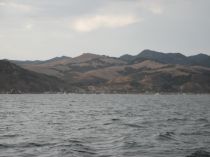 Port San Luis from our mooring ball
Port San Luis from our mooring ball Will plotting a course while Mike drives
Will plotting a course while Mike drives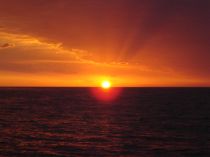 Beautiful sunset
Beautiful sunset Nice clouds too!
Nice clouds too!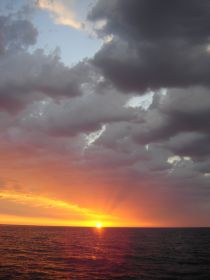 Great colours
Great colours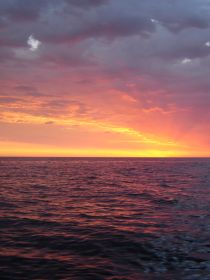 Very pretty
Very pretty Mike at the helm
Mike at the helm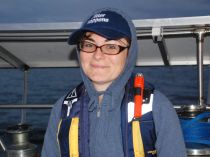 Sara looking cute
Sara looking cute Lightning storm photo collage
Lightning storm photo collage